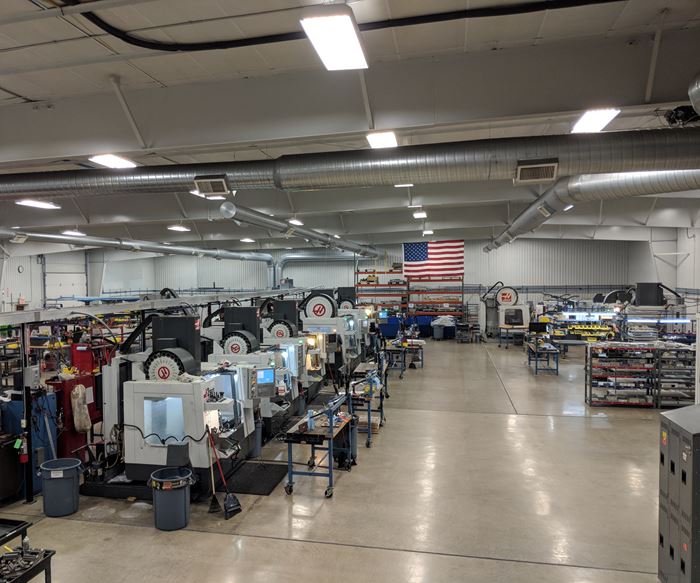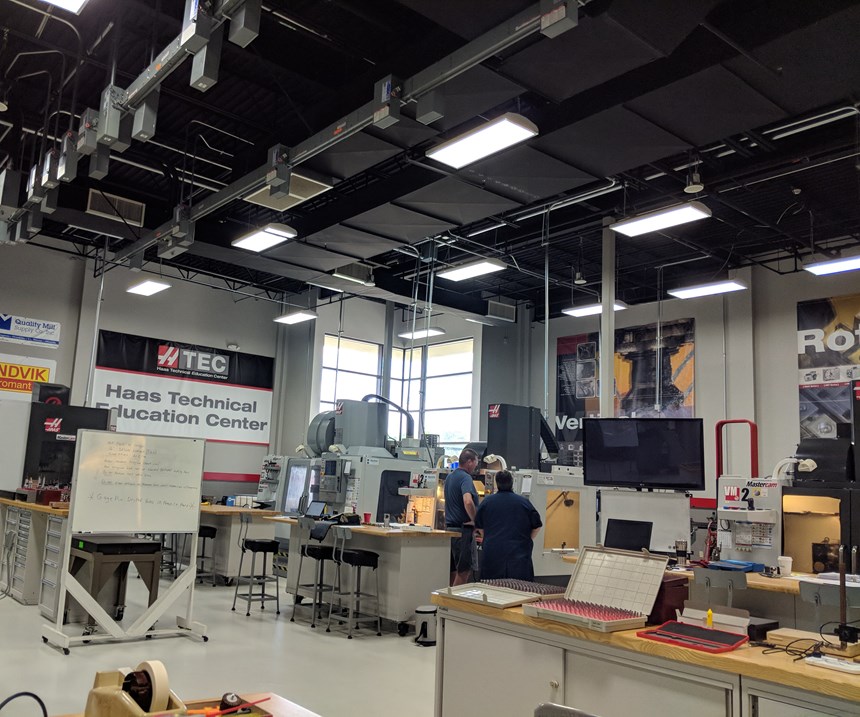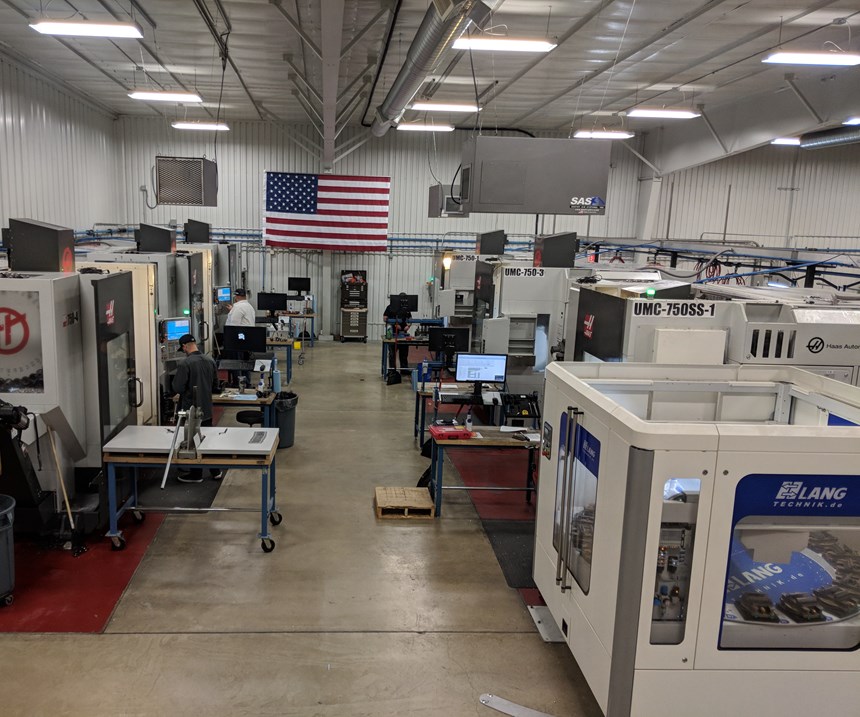The Benefits of Being a One-Brand Shop
This shop finds advantages in having CNC machines from a single builder, but the general strategy has benefits that can be applied to any startup shop.
Share




Flying S, an engineering consulting company that manufactures aviation and aerospace components, has been using machine tools from Haas Automation (Oxnard, California) since early in the history of its machine shop. Its first machine tool was a used, manual Bridgeport it converted into a CNC and dubbed “Bertha.” As they outgrew Bertha’s limitations, the shop purchased its first CNC, a used Haas VF-4SS. As the company expanded, it stuck with machines from that builder. This is a strategic decision that has some very specific benefits for Flying S:
Range of machines. Haas makes a wide variety of machine tools, so when Flying S wanted to add new types of machines, it did not need to go to another brand. Flying S has taken advantage of the company’s selection. Among its 26 machines are CNC vertical machining centers (VMCs) ranging from a small a VF-2YT to a VF-10, lathes like an ST-30SSY with a bar feeder, a GR-712 gantry router and multiple UMC-750 five-axis machines.
Specialized knowledge. Peter Bowman, who joined Flying S in 2010 as a manufacturing engineer, has completed the master apprenticeship program at Haas. Since then, he has been able to apply his previous experience to get the most out of the machines and keep them running optimally.
Machines at the ready. In addition to small-batch aerospace work, Flying S specializes in prototypes with short lead times. “We can do carbon composite parts from an aluminum mold in about two days,” Mr. Bowman says. To facilitate this kind of work, the company needs to have machines open and available. Buying machines outright helps Flying S avoid the financial pressure of keeping the machines running to make monthly payments.
Training access. Flying S is located about 30 minutes from a Haas Technical Education Center (HTEC) at Vincennes University in Vincennes, Indiana. Flying S’s founders David and Penny Shaw say that when they moved back to his family’s farm in Palestine, Illinois, they wanted to start a business that made use of the area’s resources. With a Haas training center nearby, it was natural to select machines from this builder when they decided to expand their engineering consulting firm into machining as a first step into manufacturing.
Along with the specific advantages of the dynamic between Haas and Flying S, the machine shop experiences more general benefits of this strategy that can be applied to any startup shop:
Same CNC on all machines. If operators know how to run one of Flying S’s machines, they can pretty much run all of them. This eliminates issues caused by having machines or controls that can be run only by employees with certain specialized knowledge. “I don’t have to worry about someone not having enough work to stay busy,” Mr. Bowman says. “Another advantage of standardizing to the Haas control is that our shop only uses three CAM postprocessors: lathe, mill and five-axis mill.”
Simplified machine maintenance. Using the same brand of machine also makes it easier for the company to keep its machines well-maintained. For example, Flying S uses a Renishaw ballbar-testing system to check its machines and ensure they can hold the tight tolerances its customers require. If a ballbar test reveals that a machine component is worn out, the company can quickly replace it. The machines at Flying S also use many of the same spare parts, so it is easy for the company to keep them in stock. In addition, many of the machines are serviced similarly. For example, when a spindle needs to be replaced, the installation process is almost exactly the same, regardless of the year or type of machine, and can be completed in house. Mr. Bowman adds that Haas Automation provides service training videos and documentation, which Flying S has incorporated into their maintenance program.
Sandardized tooling. Because the machines are all the same brand, they can use most of the same cutting tools, workholding and accessories. This saves money, and because operators do not need to worry about dealing with a wide range of products, the risk of errors, shortages and other problems is reduced.
Parts designed for the machine. Working exclusively with a certain machine brand yields insights into the capabilities of those particular machines. Companies can use this knowledge to design parts that can play to these strengths. “When we are familiar with the strengths of the machine tool, we find that we have much better results,” Mr. Bowman says. “For example, deep backside pockets on large, aluminum-composite molds can be difficult to cut with standard CAT40 spindles. However, we taper backside pocket walls to reduce tool engagement and use high polish, high positive inserts to reduce spindle load. This way, we do not need expensive dual-contact machine spindles.”
Easier automation. If a shop using one machine tool brand implements an automation system at one machine, it will be easier for that shop to apply the system to its other machines. Integration and testing will be smoother and quicker as more systems are added. For example, Flying S installed a Lang Eco Compact pallet changer on a UMC-750SS five-axis machine. When the shop automates more machines with this system, it will already know how to integrate it and use it effectively.
Strong supplier relationships. Working exclusively with a single company can bring special advantages. For example, Flying S is in talks with Haas to beta test one of the first UMC 1000s, which is a large five-axis machining center that is set to debut at IMTS in 2018.
Related Content
Inside the Premium Machine Shop Making Fasteners
AMPG can’t help but take risks — its management doesn’t know how to run machines. But these risks have enabled it to become a runaway success in its market.
Read MoreHow to Successfully Adopt Five-Axis Machining
While there are many changes to adopt when moving to five-axis, they all compliment the overall goal of better parts through less operations.
Read MoreBallbar Testing Benefits Low-Volume Manufacturing
Thanks to ballbar testing with a Renishaw QC20-W, the Autodesk Technology Centers now have more confidence in their machine tools.
Read MoreHow to Determine the Currently Active Work Offset Number
Determining the currently active work offset number is practical when the program zero point is changing between workpieces in a production run.
Read MoreRead Next
Building Out a Foundation for Student Machinists
Autodesk and Haas have teamed up to produce an introductory course for students that covers the basics of CAD, CAM and CNC while providing them with a portfolio part.
Read MoreSetting Up the Building Blocks for a Digital Factory
Woodward Inc. spent over a year developing an API to connect machines to its digital factory. Caron Engineering’s MiConnect has cut most of this process while also granting the shop greater access to machine information.
Read More5 Rules of Thumb for Buying CNC Machine Tools
Use these tips to carefully plan your machine tool purchases and to avoid regretting your decision later.
Read More


























.jpg;maxWidth=300;quality=90)







